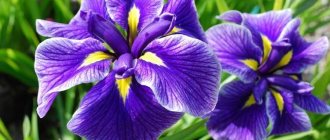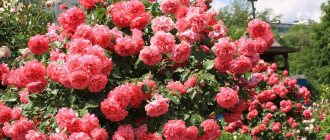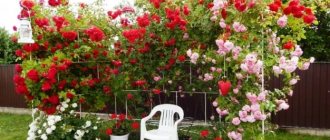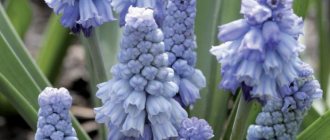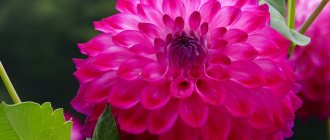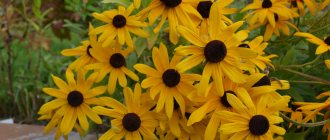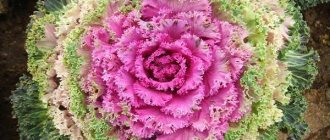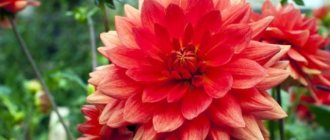Dahlias (Dahlia) are directly related to the Aster family. This plant is one of the most spectacular and long-blooming flowers that are grown in the garden. Dahlias have a fairly wide palette of colors, and the flowers can have a wide variety of shapes. Their flowering is quite long, lasting from mid-summer until the first autumn frosts, and this is the most important advantage of dahlias. The varieties, shapes and colors of such plants are very different.
They can decorate both a flower bed and a border line. And if desired, you can use it as a single or even indoor flower. Such beautiful flowers are distinguished by their undemanding and non-capriciousness. If you choose a good place for planting in open ground, and also feed and water the plant correctly, it will grow very quickly and bloom profusely.
How to plant dahlias in a flowerbed
These are the most successful and beautiful companions for dahlias.
1. Red daylily, or daylily (Hemerocallis). 2. Kniphofia. 3. Loosestrife (Lythrum salicaria). 4. Cactus dahlia. 5. Pompon dahlia. 6. Simple (non-double) dahlia. 7. Acute-flowered reed grass (Calamagrostis acutiflora). 8. Switchgrass (Panicum virgatum). 9. Pyrethrum parthenium. 10. Veronica longifoiia. 11. Crocosmia (Crocosmia masoniorum). 12. Catnip, or catnip (Nepeta)
The balcony composition of pink cactus dahlias, graceful sultan inflorescences of pennisetum and large cosmos baskets is distinguished by its amazing lightness.
Flowerbed with dahlias and other flowers
Tall dahlias fit perfectly into a flowerbed of perennials , the peak of flowering of which occurs in the summer.
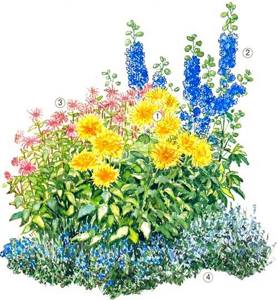
In our flower garden
- Golden yellow cactus dahlia,
- Delphinium hybrid,
- Monarda,
- Common Dubrovnik (Teucrium chamaedrys).
Regularly remove faded dahlia inflorescences, then the flowerbed will retain its beauty for several weeks. Delphinium will bloom a second time at the end of summer if its flower stalks are cut off immediately after the first flowering.
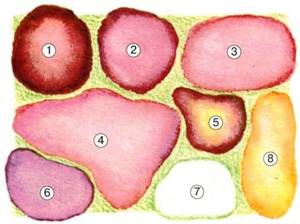
1 – dahlia, 2 – cleome, 3 – mallow, 4 – sage, 5 – nolana, 6 – ageratum, 7 – iberis, 8 – marigolds.
The design of this flower bed is in red and pink tones. The plants are selected so that the flowerbed will bloom continuously throughout the summer season.
When composing a flower arrangement, many factors are taken into account - the harmony of the shape and color of plants, their combination in height.
Tall dahlias can serve as a backdrop or soloists in a flower garden. In the first case, they are planted in the background and they highlight the beauty of the entire flowerbed. In the second case, the appearance of tall solo plants sets the tone for the entire composition, because the main emphasis is on them.
Lower plants are added to dahlias. If tall plants acted as a backdrop, then solo flowers can be found in the middle tier. If tall plants occupy a central position in the flowerbed design, flowers of medium height play an accompanying role.
The gaps in the flower bed are filled with plants with decorative foliage or ground cover with modest flowers. Their role is to connect all parts of the composition together, to be the background. They try to design the flowerbed in such a way that flowering on it continues throughout the season, as in a flowerbed of continuous flowering.
Choose specific plants for your flower bed
Choose from the entire range of annual, perennial and bulbous flowers that suit you best. When choosing plants, consider:
- flowering time – at least 3-5 plants in the composition should bloom at any given time.
- conditions for keeping flowers - convenient if plants need the same watering and the same fertilizers
- harmony in the design of the flowerbed - select plants that are harmoniously combined in height, shades and shapes of inflorescences (which have the same flowering periods).
- personal preferences - start creating a flower bed with your favorite dahlias, adjust the rest of the design to them.
General information about dahlia
The dahlia, or dahlia as it is scientifically known, belongs to the Asteraceae family.

According to various sources, the genus of this plant includes from 4 to 42 varieties. The plant was first noticed in the mountains of Guatemala, Mexico and Colombia. From these countries, the first representatives of this species were brought to our country.

In landscape design, low-growing varieties are used to form arrays, borders or ridges. Other species look good in compositions in flower beds and in group plantings.

For single plantings, it is better to choose large, abundantly flowering varieties.

Those plants that are supposed to be cut must have a strong and long stem. Annual plants are thrown away after flowering.

The dahlia can safely be called the queen of the garden plot. The splendor of shapes and colors decorate the garden with luxurious flower beds with lush greenery and colorful inflorescences.
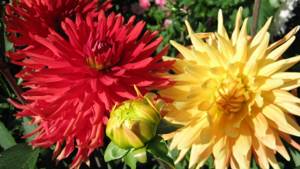
The advantage of these spherical flowers is that the riot of colors lasts until late autumn. These are the only summer plants that have this property.

Main varieties with photos
The classification of these plants is related to the structure, as well as the shape of the flower itself. At the moment, there are 12 classes of dahlias. However, new classes are gradually appearing and this is associated with the formation of new varieties. Below are the varieties that are most popular:
Simple They have one row of petals, the diameter of the flowers is 10 centimeters. The height of the bush, as a rule, does not exceed 45–60 centimeters. The main varieties are: Princess Marie Jose - pink, Yellow Hammer - yellow, and Orangeade - orange-red.

Anemoneaceae
There are 1 or more rows of marginal petals. In the middle they are tubular and elongated. The diameter of the inflorescences does not exceed 10 centimeters, and the height of the bush can be 60–90 centimeters. The main varieties are Lucy with a lilac-yellow color, bronze Vera Higgins and Comet with red color.
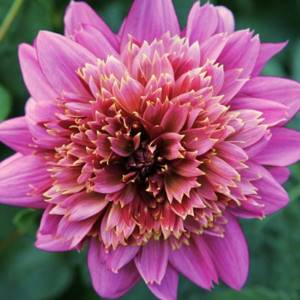
Collar
The diameter of the flowers is approximately 10 centimeters, and the height of the bush can reach 75–120 centimeters. There is 1 marginal outer row of petals; directly along its top there is another row of twisted and short petals of a different color, which is similar in appearance to the collar. The main varieties are gold and scarlet La Gioconda, Chimborazo cream and reddish, Claire de Luna cream and yellowish.
Peony-shaped

The diameter of the flowers is 12–15 centimeters. The marginal flat petals are arranged in 2 or more rows, and tubular petals are located in the central part. The height of the bush is 75–120 centimeters. Main varieties: crimson-red Symphonia and lilac Fascination.
Dahlias Cheerful guys - combination with other flowers in flower beds
Bright, multi-colored decorative dahlias are a real decoration for flower beds and compositions. Among the many varieties of garden flowers, annual dahlias “funny guys” occupy a special place, thanks to a number of valuable advantages. For example, drought resistance allows them to be grown in regions with intermittent water supplies and in the absence of frequent rains. Even novice gardeners can grow low-maintenance flowers. The biggest fans of annual flowers can breed them at home, for example, by planting them in flower beds. Designers use bright and cheerful dahlia bushes to form flower beds, edgings or borders. If the garden plot is located on a slope, it can be planted with a continuous array of dahlias. A friendly family will look great as an independent decor or in combination with other flowers in flower beds: petunias, asters, marigolds.
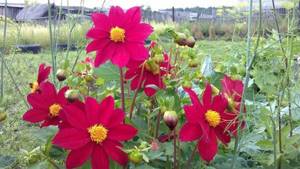
You just have to adhere to the rule that other flowers should be less bright, preferably the same shade. The combination of bright dahlias with blue flowers, such as delphinium or sage, looks very original and unusual.
Criteria for choosing a landing site
When choosing a place to plant dahlias, you should remember that these flowers do not like drafts. In this case, the place should exclude air stagnation.

In addition, dahlias love the sun. Therefore, shaded parts of the site should be excluded.

The special structure of the soil will also promote the growth and flowering of dahlias. The soil should be drained and easily allow water to penetrate into the deeper layers to nourish the roots.

Heavy and depleted types of soil are not suitable for this type of plant. You also need to exclude poor and overly damp lands.

The nutritional value of the soil in this case will be of paramount importance. It can be enriched with humus and compost. These measures will lead to increased soil fertility.

This procedure must be carried out in advance, since the soil must settle. Other beneficial additives will be added directly during planting.

Advantages and disadvantages
The advantages of annual dahlias include the following :
- annual varieties bloom in the first year of planting and bloom much more intensely than perennial varieties;
- long flowering period: from the beginning of summer until the first serious frost;
- annual flowers are propagated by seeds, which do not require special storage conditions, unlike tubers of perennial plants;
- take root in any climate, even the harshest;
- more resistant to various diseases and rot.
Annuals have few disadvantages:
- the flower does not overwinter, and a new plant must be grown every year;
- seeds of hybrid varieties do not retain the properties of the mother plant, so in some cases the flower’s own seeds will not produce exactly the same plant, and it is necessary to purchase them in a new way.
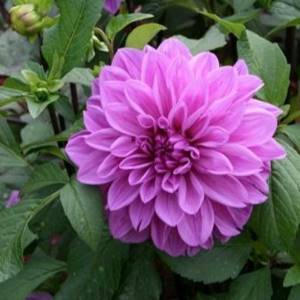
Planting dahlias according to all the rules
Before planting, the bed must be re-fertilized. Non-leaf compost, which needs to be scattered over the surface, is suitable as a feed. In addition, you can use a few handfuls of wood ash. It is better to use a rake for mixing.

For each root, you need to dig a hole 2 or 3 times larger than the roots themselves. After immersing the roots in them, about 7 cm should remain free.

If tall varieties of dahlias are used for planting, then it is better to pre-install supports so that later, when placing them near an already planted plant, the roots will not be damaged.

Planting is done quite deep. The stem should sink about 5 cm into the ground.

Immediately after planting, the plants should be watered generously with water at room temperature.

The ground around the seedlings should be covered with crushed bark and sawdust. This mulching will save young shoots from being eaten by snails.

Soil preparation and planting
To get a good harvest, the soil must be properly prepared. The optimal composition for planting flowers should contain nutritious soil, sand and humus. You can buy ready-made soil at a flower shop, or you can collect it in a meadow, preferably in a place where clover and other herbs bloomed. The composition should contain 2 parts of soil and 1 part each of humus and sand. A few days before planting the plant, the soil should be disinfected with a warm solution of potassium permanganate, and for greater guarantee, it should be calcined in the oven for 2-3 hours.
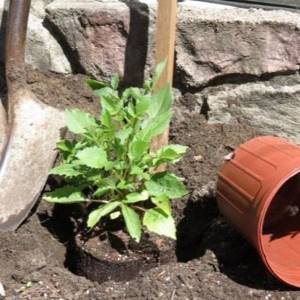
Making a good dahlia bush
As the seedlings grow, they form into bushes. A plant grown from a tuber is created by removing the smallest shoots. Only the 2 largest and strongest are left for further growth. It is important to carry out this procedure as early as possible.

If propagation was carried out using cuttings, then only one stem can be left. In this case, you need to pin it on top above the third sheet. Then you can get a lush bush from one stem.

In order for large-flowered varieties to be lush and beautiful, it is necessary to remove those shoots that appear in the axils of the leaves. This will save useful elements for the growth and development of the main flower.

If the bush turns out to be too thick, then you need to provide it with the necessary ventilation. To do this, it is enough to remove all leaves from the trunk at a height of 40 cm.

If the choice fell on small-flowered varieties:
- dwarf;
- pompons;
- collar,
then caring for them will be much easier. In this case, there is no need to form bushes.

Top dressing
If the plant was initially planted in a nutrient medium, no additional feeding is required. If the soil is poor, it can be fertilized with organic matter in the fall. During the growing season, it is recommended to feed plants with complex fertilizers - this way they will bloom better . After adding food, the bushes need to be watered.
During flowering, the plant can be fed with phosphorus and potassium.
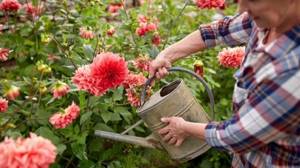
Watering dahlias and feeding them
Immediately after dahlias are planted, they require daily watering for a week. After this, watering occurs less frequently. The amount of water is reduced so that the soil does not dry out.
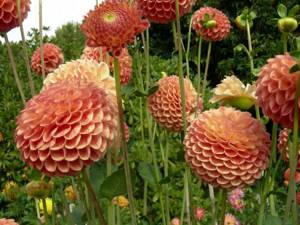
To maintain optimal moisture, the soil should be mulched. Humus, compost and peat are suitable for this. However, regular watering is not excluded.
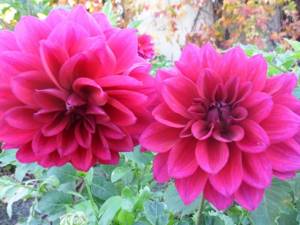
The hotter the days, the more often you need to water the plants. After each watering, it is necessary to loosen the soil, remove weeds and similar regular procedures.

If watering rules are not followed, much fewer buds will form. Such bushes will be less lush, and their flowering will not be as abundant.
Fertilizing should be done with mineral fertilizers or organic matter on a schedule 2 times a month. The optimal temperature for the growth of cuttings will be 16-18 degrees. Temperatures below 7 degrees will not allow you to grow a full-fledged plant.

Caring for dahlias is easy. It is enough to carry out regular activities to ensure that nutrients reach the roots of the plant. In addition, you need to ensure that pests do not spoil the leaves and shoots of plants. The result of such care will be a bright garden with lush flower beds of various shades.
Caring for annual dahlias
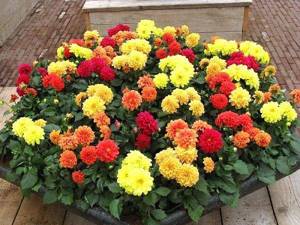
Annual dahlias are easy to care for. Unlike perennial varieties, they do not need regular fertilizing, since they do not have time to use up soil reserves. If other plants previously grew on this land, when planting dahlias, you can add organic fertilizers (humus, compost), as well as mineral potassium or sodium mixtures. During the flowering period, wood ash will be useful.
There are several rules for caring for annual dahlias:
- It is worth watering flowers only when they suffer from severe drought;
- if you periodically pinch the tops of the shoots, the bush will grow more luxuriant;
- The soil in the flowerbed should be regularly loosened, while trying not to damage the rhizome;
- After flowering, you can collect seed boxes and plant them next year.
To decorate your garden, you should choose annual varieties of dahlias. In addition to ease of care, they are distinguished by longer flowering. The first buds appear in early June, and the last ones fade only with the onset of frost.
Disease and pest control
Dahlias are most often susceptible to diseases of gray or brown rot, the causative agent of which is considered to be a pathogenic fungus. The disease can develop if the seedlings are planted too densely or there is stagnation of moisture near the roots. The disease manifests itself in the drying out of peduncles and leaves. Preparations containing fungicides are used as treatment. The planting site must be treated with lime solution. Leaf spotting is an equally common disease; it is expressed in the appearance of yellow and brown spots on the leaves. The reason is poor air circulation and dense planting.
The plant can also be affected by various parasitic insects: aphids, strawberry or chrysanthemum nematodes, plant bugs, slugs and other pests. Most often, the affected areas of the plant are cut off, and the flower itself is treated with special preparations.
For example, “Fitoverm” and “Aktara” help against aphids, and it is recommended to use “Mospilan” or “Iskra-M” against bedbugs.
Magic dahlia flowers: how to grow and care for plants

Decorating a flower bed is a responsible task for every gardener. Among the huge variety of plants, tuberous species are distinguished by their ease of planting and care. One of these specimens are dahlia flowers ( or dahlia), whose beauty has been known since ancient times. There is even a legend that the appearance of these cultures occurred immediately after the end of the Ice Age. Whether this is true or not has not been scientifically proven, but some kind of magical power is present in this plant, because its charming appearance is mesmerizing.
Dahlias for a bouquet for September 1
Rules and traditions, fashion and tastes change. Once upon a time, asters were popular, today dahlias are no longer a rarity or a curiosity in school bouquets. Flowers of exceptional beauty are great for bouquets and prolong their beauty, since the first frosts are traditional before September 1st. True, when cut, their lifespan is short, and the heavy “caps” of large inflorescences often droop and can break. To prolong the life of dahlias, florists recommend scorching a fresh cut of the stem with fire so that the released juice does not interfere with the flow of water.
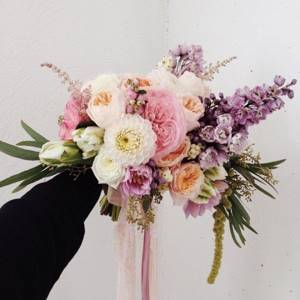
Photo of bouquets for the teacher made from dahlias plucked from a flowerbed

